Fujifilm HS20 EXR Review
Fujifilm HS20 EXR
Can Fujifilm's latest feature-rich 30x superzoom deliver the image quality to match its DSLR styling?
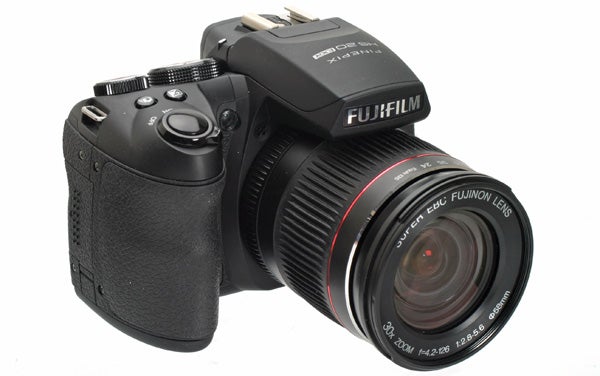
Verdict
Pros
- 30x zoom covers everything
- High-speed movie shooting works well
- EXR modes capable of good results
Cons
- Image quality dissappoints
- Quite big and bulky
- Electronic viewfinder is horrible to use
Key Specifications
- Review Price: £330.00
- 16-megapixels
- 30x optical zoom (26mm- 720mm)
- 1080p Full HD movie recording
- EXR shooting options
- 3in, 460k-dot LCD
While Fujifilm is well established as one of the leading players in the superzoom-bridge market, it’s fair to say that sector has found itself in a bit of a tight spot in recent years. Traditionally positioned as a sort of halfway-house between a regular short-zoom compact and a fully fledged DSLR, superzoom-bridge cameras have found themselves up against increasingly stiff competition from the new breed of interchangeable-lens compact system models in recent years.
Yes, it’s certainly true that compact system cameras aren’t able to offer the 30x or even 20x optical zoom power of a traditional superzoom, however they do have the advantage of bigger sensors that result in better overall image quality. The latest compact-bodied models of this type – for example, the Lumix GF3 or Sony NEX-5 – also have the advantage of being smaller and lighter than any current superzoom-bridge models.
Clearly aware of this increasing threat from compact system cameras, manufacturers have responded in two primary ways: by extending the telephoto capabilities of their models even further, and by packing all kinds of innovative technology and useful features into them. While this certainly benefits consumers, can models like the HS20 also deliver the image quality to match their undoubtedly impressive feature-set and DSLR-like form factor?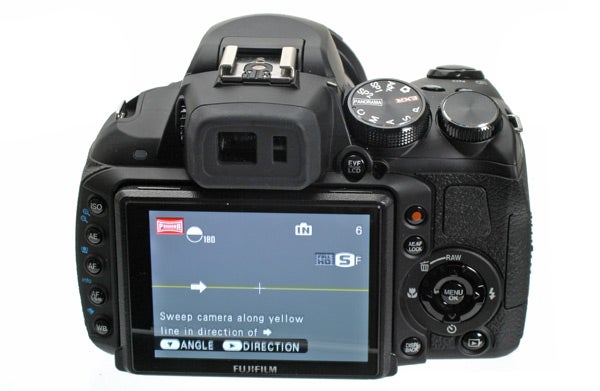
The HS20 picks up pretty much where the HS10 left off, bringing a number of notable specification upgrades to the table. Chief among these is sensor resolution, which has been upped from 10- to 16-megapixels. The 3in rear LCD monitor also benefits from a hike in resolution from 230k- to 460k-dots.
Of course, these aren’t the only tweaks and changes – there’s a notable increase in dynamic range performance from 400% to 1600% too – but elsewhere the headline specs remain much the same, with the HS20’s 30x optical zoom, 1080p Full HD movie recording and Raw still image recording abilities all carried over directly from the HS10.
With its huge fixed zoom the HS20 is primarily a camera of convenience; there are no heavy camera bags to cart around, and no awkward lens changes to make in dusty environments either. It’s essentially an all-in-one camera – something that can be counted on, no matter how near or how far your subject is. For many this flexibility is undoubtedly its biggest appeal.
At its heart the HS20 uses a 1/2.3-inch, 16-megapixel EXR CMOS sensor – exactly the same one that’s used in the Fujifilm F550 EXR travel compact. This chip benefits from being backside-wired, an arrangement that allows more light to reach the individual photo diodes, thereby increasing the performance of the sensor in low-light. In addition, it also benefits from Fuji’s EXR sensor technology that employs a triple-layer pixel array, which allows the sensor to optimise for resolution, sensitivity or dynamic range, depending on the scene it’s faced with.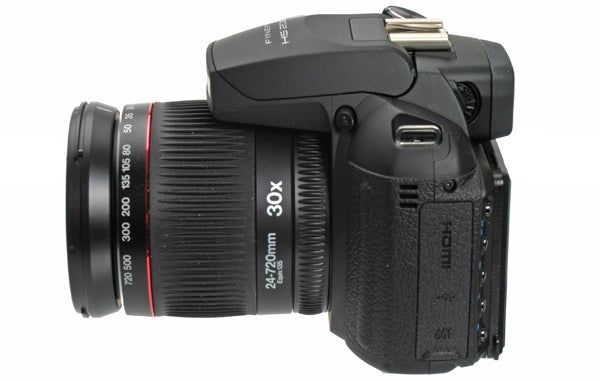
Still images can be recorded at a maximum 4608 x 3456 pixels in the default 4:3 aspect, with further options to record at 8MP and 4MP at 4:3. Other aspect options include 3:2 up to a maximum 14MP resolution of 4608 x 3072 pixels and 16:9 up to a maximum 12MP at 4608 x 2592 pixels. In addition to Fine and Normal JPEG quality settings the HS20 can also be set to record images as lossless Raw files (.RAF format) or even Raw JPEG.
This 16MP EXR sensor is backed up by Fuji’s multi-core EXR image processor that allows for some seriously speedy shooting in both stills and video mode. Indeed, high-speed shooting has become something of a trademark of Fuji superzooms in recent years, and while the HS20’s more densely populated sensor prevents it from reaching the dizzying speeds of its predecessor (owing to the larger files it generates) it’s still capable of an impressive 8fps continuous shooting at full 16MP resolution, rising to 11fps at 8MP.
Movies get the same high-speed treatment too, with the ability to record VGA-resolution movies at 80fps, QVGA-resolution movies at 160fps, or even 320 x 112-pixel movies at 320fps – all of which will play back in varying degrees of slow-motion on a computer or compatible device. If you’d prefer to opt for quality over speed then the HS20 duly obliges with a maximum 1920 x 1080p Full HD movies at 30fps, or 720p HD movies at 60fps.
As per the Taking advantage of this speed, the HS20 offers an above average range of bracketing options – from standard exposure bracketing to film simulation and dynamic range bracketing too.
As is the norm with advanced superzoom models, the HS20 offers the regular quartet of semi- and fully manual shooting modes: Program, Aperture-priority, Shutter-priority and Manual (PASM). Looking further around the dial there’s also an Automatic (scene recognition) point-and-shoot mode, along with 17 individual Scene mode options – two of which can be assigned direct-access points on the shooting mode dial.
In addition to these standard options, the HS20 also offers two Advanced shooting modes, along with three EXR-specific modes. While these modes do have their benefits they all produce images at a lower overall resolution than the standard shooting modes, up to a maximum 8MP.
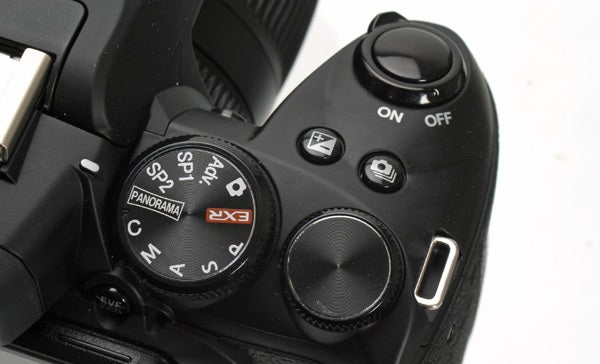
Turning first to the Advanced shooting modes: the portrait-orientated Pro Focus mode and the noise-reducing Pro Low-Light mode. Both options take advantage of the camera’s high-speed shooting abilities by taking multiple exposures in quick succession with a single shutter press before combining them to produce images with a shallower depth of field (Pro Focus mode) or less noise (Pro Low-Light mode).
On the other hand, the three EXR shooting options – High Resolution, Dynamic Range Priority and High ISO & Low Noise – all exploit the characteristics of Fuji’s proprietary sensor to achieve their goals.
The first of these, High Resolution, uses the full 16-megapixels to deliver images that can be blown up to poster-sized prints. The Dynamic Range Priority option, meanwhile, optimises the camera for better results in high-contrast scenes, while the High ISO & Low Noise mode offers greater sensitivity and improved results in low-light conditions. If you’re not sure which one to use, the camera can be set to choose the right setting automatically.
Rounding off the HS20’s range of shooting modes is the Motion Panorama option that allows you to create 120, 180 or 360-degree panoramas with a single button press by simply panning the camera in a preset direction. As far as panoramic technology goes, we find the Fuji option to be only slightly behind Sony’s excellent Sweep Panorama in terms of overall image quality and ease of use. These two are currently way out in front at the moment – other manufacturers have some distance to make up.
The HS20 takes its design cues directly from a traditional DSLR and the overall dimensions are exactly the same as its predecessor. It’s not a particularly small or lightweight camera, and it’s even possible to find entry-level DSLRs that are about the same size. Of course to obtain the same kind of telephoto power on a DSLR that the HS20 possesses would require you to fit a fairly huge lens.
The finger grip is deep and rubberised, which allows you to get a firm and secure hold of the HS20, even with just the one hand. This is further aided by a contoured thumb-rest on the back. This thoughtful approach extends to the other side of the body where the body benefits from further rubberised finishing, allowing both hands to get a good grip. 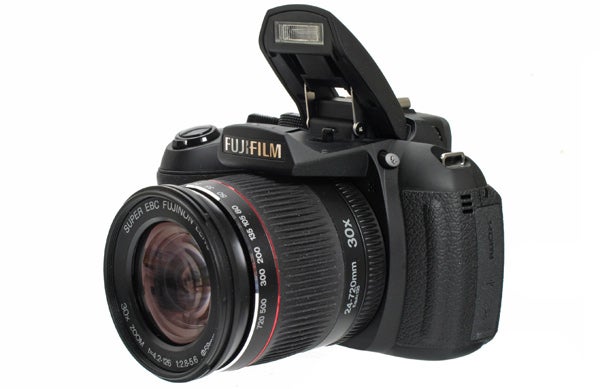
Buttons are nicely spaced and it’s good to see a generous number of quick-access buttons for regularly used settings, such as EV compensation, ISO and AF mode. We also like the small operation dial (the one next to the shooting mode dial) that allows you to easily change settings with your thumb.
We’re big fans of the manually operated zoom too. Not only because it makes precise framing so much easier than having to fiddle around with a spring-loaded switch, but also because it’s far, far quicker going from one zoom extreme to the other. This quickness means you’ll be ready to frame and shoot in an instant, whatever situation you’re faced with.
Or at least you would be, if only the camera was a bit more responsive and a bit quicker. We timed the HS20’s start-up time – the time taken from being switched off to being focused and ready to capture – at a rather sloth-like 3.5 seconds, which significantly trails those equivalent DSLRs.
Autofocus performance isn’t particularly quick either, with a slight delay perceptible between the act of half-pressing the shutter button and the AF system actually kicking into gear. It’s not a huge delay – we’re talking tenths of seconds here – but it is noticeable, even when the camera is used in good light. Once the AF system gets past this small hiccup, however, it’s actually pretty fast to achieve focus.
Processing speed depends largely on the settings used and the complexity of the recorded scene. Regular 16MP JPEGs shot on the Fine detail option take a couple of seconds to fully process, although the HS20’s buffer will allow you to carry on shooting before this processing has finished. Shooting in Raw does slow things down though, and if you’re shooting JPEG and Raw simultaneously, then you can expect to be able to shoot about two images in succession before the HS20 locks up for around five seconds while the buffer clears.
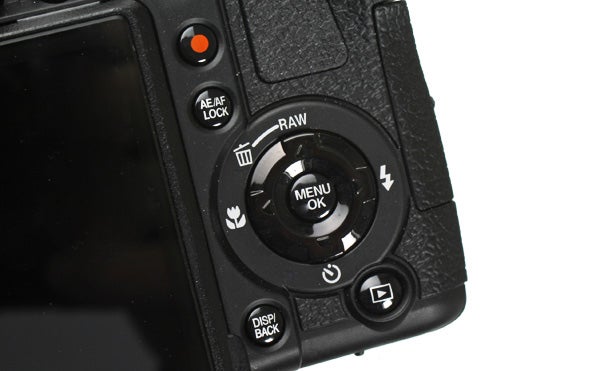
The 3inch LCD monitor on the back of the HS20 sees a notable upgrade over the HS10, with the new 460k-dot monitor offering much better performance with sharper images and better punchier colours. Sadly though, the same cannot be said of the Electronic Viewfinder (EVF).
According to the Fujifilm website, the HS20’s EVF even sees a minor reduction in resolution from the HS10’s – down from 220k-dots to 200k-dots. In practice it’s really quite horrible to use – on the plus side there’s an eye-sensor that automatically turns it on and off, but otherwise it’s small and poky, all colour is completely washed out and the viewable image suffers from all manner of flickering and juddering, something that gets progressively worse as the available light deteriorates.
While we are willing to concede that the EVF could help out in bright sunshine where the LCD screen is hard to see, it really doesn’t add to the camera’s overall appeal. In fact, if this is the best that Fujifilm can do then they’d probably be better off removing the EVF altogether from the HS20.
Moving swiftly on to battery performance, the HS20 doesn’t come with a proprietary rechargeable Li-ion battery. Instead it uses 4x regular AA batteries that slot inside the chunky finger-grip (could this be the reason it’s so large? We think it might.). Battery performance will vary depending on the type and quality of battery being used, but we’d certainly recommend investing in a set of decent rechargeable batteries. During the course of our test we used 4x regular Duracell batteries – enough to leave us with power to spare after over 300 captures.
We were left feeling a bit underwhelmed by the overall image quality of the HS20. Certainly compared to the Fujifilm F550 that we recently tested, the HS20 seemed to come up a bit short. No doubt part of the problem is the perceived ability of the HS20 – with its DSLR-like styling and rich feature-set it’s all too easy to assume it will produce images of DSLR-like quality, which it most certainly doesn’t.
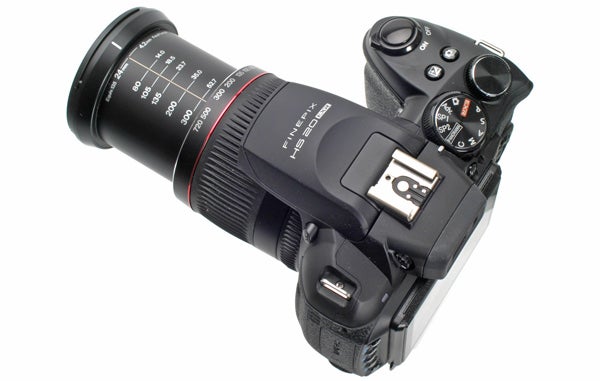
That’s not to say image quality is particularly bad, because it’s not. Indeed, the HS20 is perfectly able to hold it’s own against many mid-range and advanced-level compacts, it’s just that given the price, feature-set and form factor you might well expect it to produce a bit more.
On to the specifics, metering is generally quite accurate, albeit when the camera is used in one of the standard shooting modes outside of the EXR settings, there is a slight tendency for the camera to overexpose, sacrificing highlights in return for extra shadow detail. The Dynamic Range EXR mode performs quite well, producing images with more punch. Used on the Auto White Balance setting, we didn’t experience any major problems, even when moving from unbroken sunshine to artificial lighting
We found colour to be pleasingly accurate, albeit slightly muted when the camera is used on the ‘Provia’ Standard film simulation setting. Opting for the ‘Velvia’ Vivid setting instead does go some way to alleviating this by adding more vibrancy to processed images. We also found that using the camera in EXR Dynamic Range mode produced images with more punch and contrast when used in bright sunlight too.
While looking through our sample images, the lack of sharp edges quickly established itself as the HS20’s major bugbear. Given that the single biggest selling point of the HS20 is its huge zoom this lack of basic sharpness is a real let-down. The problem isn’t confined to using the camera at the far reaches of its telephoto capabilities either – indeed the sensor-shift image stabilisation does a noteworthy job of compensating for camera shake at long focal lengths. Rather the problem crops up at wideangle settings too. As is often the case with superzoom lenses the trade-off for being able to cover all focal lengths with a single lens is a compromise in overall image quality.
Verdict
On paper the HS20 looks to be an attractive proposition. The 30x zoom certainly appeals, as does the range of advanced shooting modes. However, it’s important to bear in mind that despite its DSLR styling and dimensions the HS20 is essentially an advanced compact and delivers image quality to match. If all-in-one convenience tops your priorities then the HS20 certainly ticks a lot of boxes and is well worth a look. If, however, image quality is equally or more important then you might want to consider eschewing the 30x zoom and try out some entry-level DSLRs or perhaps even a rangefinder style compact system camera instead.

ISO 100 images are noise free but do lack sharpness

At ISO 200 the gain in noise is barely perceptible

By ISO 400 however, noise is beginning to creep in

And by ISO 800 noise has begun to visibly soften the image

ISO 1600 results in visible noise and image softness

ISO 3200 is for emergency use only really

Using the Signal to Noise EXR shooting mode at ISO 800 produces a smaller image overall but does reduce the effects of noise

This image was taken using the Signal to Noise EXR shooting mode at ISO 1600

At 26mm the HS20 has the whole scene covered

While the 720mm telephoto extreme brings faraway objects close

The HS20 delivers accurate colour…

…but alas edge sharpness isn’t the greatest, especially when viewed large

The EXR shooting modes can deliver extra contrast

Although they do result in a loss of resolution

Used in the ‘Velvia’ vivid colour profile the HS20 delivers pleasing colour

The HS20 offers a useable macro mode
Trusted Score
Score in detail
-
Value 7
-
Design & Features 8
-
Image Quality 7
-
Build Quality 8

